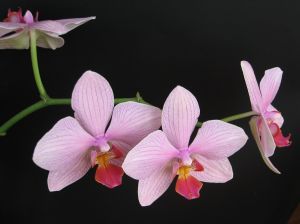Not very many people are willing to even to attempt to grow or care for orchids, as it can be a very daunting task, even for the most skilled gardener. Orchids are very expensive plants to purchase, and since they come from exotic places, can be difficult to care for properly in the more extreme climate of the United States, but it can be done. To really care for your orchids, you have to take the time to learn about them, and their requirements, so that you can provide them with everything they need to grow and be beautiful. You can find a lot of information on the Internet about caring for orchids, or may want to visit your local gardening shop, florists shop, library, or bookstore for even more resources. Once you have read up on caring for orchids plants, you should be ready to try your hand at it.
One of the first things you need to do is pay special attention to the type of orchid that you have, so that you can more accurately gauge just how much water and food it needs. Many people are not successful in caring for their orchids because they mistakenly give them too much water, which in some cases, can be even worse than not giving them enough water. Orchids do well in humid environments, but you have to make certain that you don’t overdo it. Some types of orchids need extra water, and their soil should always be a little damp to the touch, such as the Miltonia, Cymbidium, Paphiopedilum, and the Odontoglossum varieties. You should check the soil for moisture daily in these orchids, and add water as needed, remembering to do so a little at a time, so as not to overdo it.
Other types of orchids do well and only have to have water about one time each week, and you don’t really have to worry about keeping the soil moist, as they actually do better in drier conditions. If you have Vanda, Ascocenda, or Phalaenopsis orchids, you don’t really have to worry about them as much, at least not when it comes to watering.
If you care for other plants, then you know that they require fertilizer to grow properly, and the same is true when it comes to caring for orchid plants. Your best solution when it comes to fertilizing your orchids is to purchase a brand that is designed specifically for orchids, and then make certain that you follow the package directions closely. If you give your orchids too much fertilizer, you could easily damage, or even kill them.
Just about all plants require light to grow, and orchids are no exception. To get those full, beautiful blooms, your orchid has to have adequate light. The amount of light that your orchid requires will vary, depending upon the exact type of orchid that you have. Cattleyas and Dendrobiums need more light than any other type, and thrive on it, so if you have these types of orchids, make certain that you have them in an area that gets lots of sunlight throughout the day. Phalaaenopsis and Paphiopedilums do not require as much light, and will do well in almost any area of your home.
There are ways to tell if your orchid isn’t getting sufficient light. If you look at the leaves of your orchid, and notice that they are very, very dark green, they probably need more light. If they appear red, of have a reddish tint to them, then you probably are allowing them too much light, and should think of moving them to a better location. If you have a difficult time placing your orchids in a good spot, you can purchase a specially designed light, that can provide them with artificial sunlight, and in fact, many gardeners prefer this type of light, as they are in control of it, and can monitor exactly how much exposure their orchids get each day.
If you do a good job in caring for your orchids, they could live for many, many years. As your orchids grow, you will probably need to plan on repotting them about every other year or so. When you repot an orchid, it is important that you don’t do it while the orchid is blooming, as you could possibly kill or damage your plant. It is important that you choose a pot that is large enough to hold the orchid and allow it room to grow, and that before you replant the orchid in a new pot, you carefully remove any dead leaves or roots from the orchid. Once you transplant the orchid into its new pot, you should leave it alone for about a week, and then carry on with your usual water and fertilizer routines.
You will find that caring for your orchids really isn’t that difficult, once you learn how to do it properly. Once you have a routine down for providing adequate light, food, and water, your orchid could essentially live as long as you….imagine that!





